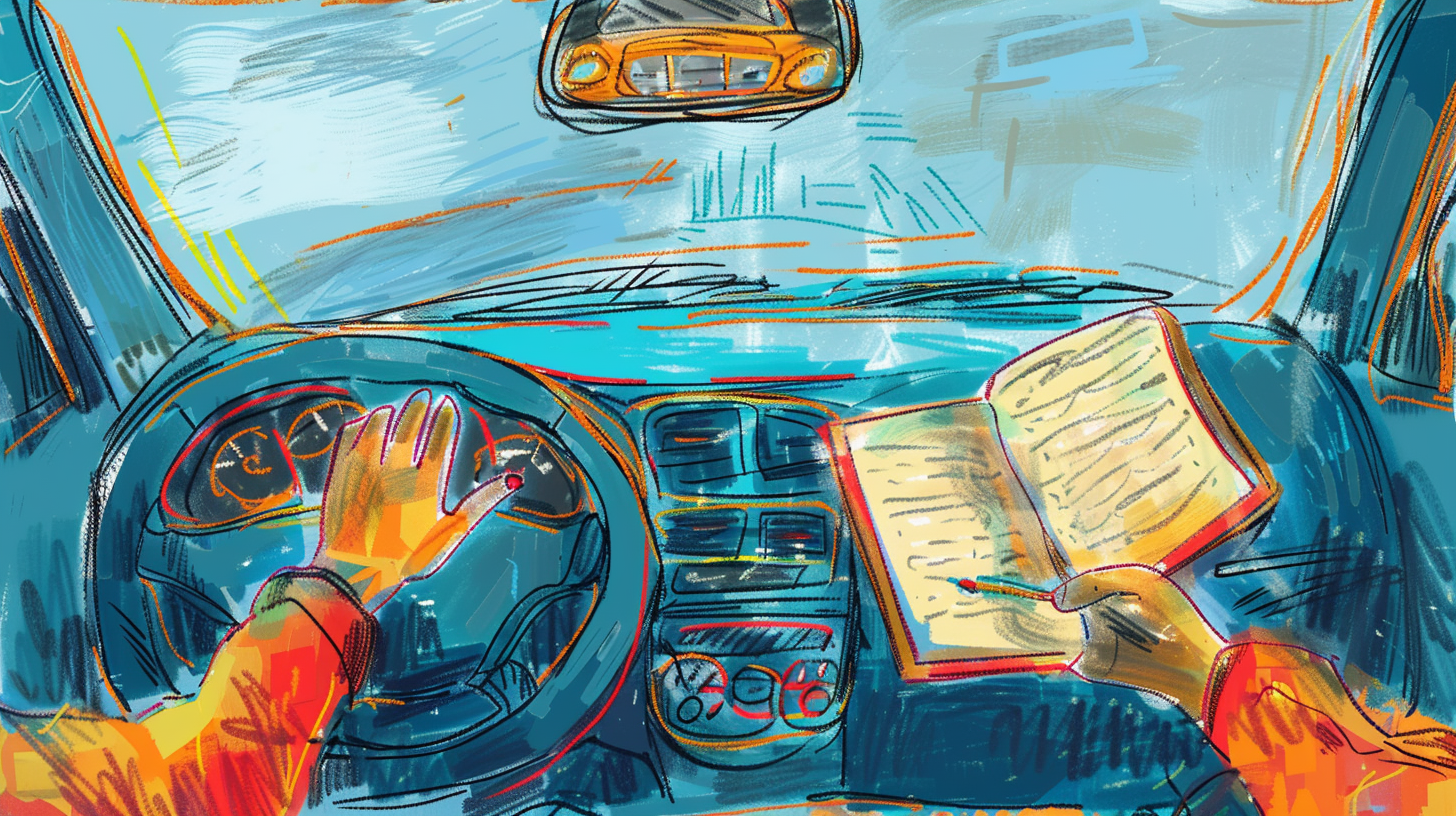You’re all set for that road trip, book in hand, but there’s a hitch—how to read in the car without getting sick. Motion sickness can turn page-turning into a nauseating challenge, but it doesn’t have to. In this text, you’ll discover the causes of motion sickness and practical tips to prevent it.
We’ll jump into why your body reacts as it does on the move and arm you with strategies to avoid nausea. Plus, you’ll learn techniques to comfortably read in the car, ensuring your literary journey is as enjoyable as your destination. Ready to turn the page on motion sickness? Let’s get started.
Causes of Motion Sickness
Explanation of Motion Sickness
It’s critical to understand what’s at play when figuring out how to read in the car without getting sick. Your brain gets cues about motion and balance from the eyes, inner ears, and body. Usually, these signals match up, but they can clash if you’re reading in a car. The eyes focused on the static page signal your body is still, but your inner ears detect the car’s movement. This sensory mismatch can trigger nausea, making you wonder why reading in the car causes sickness. It’s the brain sensing conflicting information and reacting protectively.
Causes of Motion Sickness
Multiple factors contribute to this uncomfortable condition. If you’ve thought, “Why do I get car sick when I read?” or “Why does reading in the car make you sick?” it’s due to the sensory dissonance your brain experiences. Here’s why reading in the car can lead to motion sickness:
- Visual-vestibular conflict: This is the main trigger. Your inner ears sense motion while your eyes, fixed on a book, don’t. This can also make you question why you get nauseous when reading, even if it isn’t in a car.
- Postural instability: Some experts believe maintaining balance in motion can exacerbate the condition.
- Individual sensitivity: Some of you might be prone to reading in car motion sickness simply because of a natural sensitivity.
While you might ponder if reading in the car is terrible for your eyes, rest assured, it isn’t harmful to your vision. But it does increase the risk of that unpleasant nausea. To counteract this, there’s a transition to alternatives like audiobooks. They allow you to indulge in stories without the dizzying effects of reading while driving or enduring a bumpy commute. Audiobooks can be the solution to how to read in the car, offering a way to consume literature without the nausea from reading.
If you still prefer the traditional method, there are ways to minimize motion sickness. Choose a seat where movement is less noticeable, keep your gaze up periodically to calibrate your balance sensors, and take fresh air breaks. Also, strategies to prevent nausea, like antihistamines or scopolamine patches, may aid in how not to get car sick while reading.
Remember, if you’ve ever suffered from nausea when reading or dreaded the thought that reading makes you feel sick and dizzy, switching to audiobooks during travel might be your best bet. It’s a seamless way to keep enjoying books without any of the discomfort. Plus, you’re investing in an experience that lets you say goodbye to the days of wondering, “How to read in a car without getting sick?” and hello to a new way of engaging with your beloved novels.
Tips to Prevent Motion Sickness
Choose the Right Seat
Finding the ideal seat in a vehicle is a crucial strategy for preventing motion sickness. Opt for the front passenger seat to minimize the feeling of movement. Adults and children over 12 can significantly benefit from sitting here as it allows looking straight ahead rather than through the side windows. If you find yourself in the back, grab the middle seat to keep that forward view.
On buses, getting a seat closer to the front and facing the travel direction is also effective. When you’re on a plane, choose a spot over the wing for the smoothest experience. The middle of a boat is the prime location since the motion is the least noticeable. For those on trains, facing forward and staying close to a window are keys to comfort. Choose your seat wisely to keep motion sickness at bay and improve your overall travel experience.
Look up at The Horizon
Understanding that motion sickness is often due to a sensory mismatch is vital. To counteract this, ensure you have a view of the horizon; it’s a tried-and-true method to align your senses. You are looking out at the horizon while in motion, confirming to your brain that you’re on the move. Avoid focusing on the ground whizzing by, as fast-moving visuals can destabilize your sense of equilibrium. Keeping your head still also helps, providing a consistent reference point and reducing the chance of feeling nauseous.
Control the Temperature
Regulating temperature is more influential than you might think. Highs and lows can aggravate motion sickness symptoms. Ensure a comfortable temperature by using air conditioning in the car or directing air vents towards you on a plane. When traveling on covered boats, sitting near a window gives you control over airflow and allows you to breathe in fresh air.
Do Not Read
Although the question of how to read in the car without getting sick arises often, the answer is typically unsatisfying for book lovers—reading while in motion reinforces the disconnection between your inner ears and eyes, possibly escalating motion sickness. It’s best to avoid any activity that requires intense focus, such as reading physical books or looking at your phone. For book enthusiasts, seeking enjoyment in stories without the risk of nausea means discovering alternatives like audiobooks.
No longer is getting lost in a narrative synonymous with looking at static words. Allow the storytelling prowess of audiobooks to immerse you instead – no visual focus required, so no sickness induced. By prioritizing these tips, you can manage or even prevent the discomfort of motion sickness. Engage with your journey, relish the landscapes, and perhaps investigate into an audiobook while you’re at it. This way, you keep the thrill of reading without compromising on comfort.
Techniques to Read in the Car Without Getting Sick
Choose the Right Book
Selecting the right kind of book is pivotal when opting to immerse in a book during car travel. Audiobooks emerge as a superior choice for avoiding the discomfort of reading in the car. They eliminate the need for visual focus, often a precursor to motion sickness. Engaging in an audiobook allows your ears to do the work while you can rest your eyes or gaze out at the horizon, which helps stabilize your inner ear and maintain equilibrium.
Audiobooks offer a seamless solution since many people wonder how to read in the car without getting sick. With a plethora of genres and titles available, you can enjoy the same literary adventures without the nausea from reading traditional paper books or e-readers. Notably, audiobooks are not bad for your eyes and do not contribute to reading in car motion sickness.
Sit in a Comfortable Position
Your seating arrangement in the car can significantly influence whether you experience reading in the car nausea. Please sit back and relax in your seat, ensuring it’s reclined slightly, allowing for a more natural position for your body and neck. Comfort is key here. If you’re engaging with an audiobook, you won’t need to compromise your posture to hold a book at the right angle, a common issue with traditional reading in a car.
Also, car reading with physical books requires constant adjustments to avoid glare and to keep the text in easy view. This can contribute to why reading in a car causes nausea. In contrast, audiobooks remove the struggle to maintain a comfortable reading position, making the choice clear for those who ask, “Can you read in the car without getting sick?” The answer lies in the audio format.
Take Frequent Breaks
Regardless of your reading medium, taking regular breaks can help stave off reading in car motion sickness. If listening to an audiobook, try pausing it occasionally, giving yourself a moment to take in the surroundings or engage in light conversation. These breaks are essential to prevent the nausea when reading in any form. They give your body time to rest and reset, reducing the chances of feeling unwell.
On longer trips, plan for stops where you can get out for some fresh air and stretch your legs. Movement and a change of environment can do wonders for preventing motion sickness and ensuring you remain feeling good throughout your journey. Remember, how to not get car sick while reading isn’t just about what you do in the car but also how you incorporate restful moments along the way.
Conclusion
Embracing audiobooks can revolutionize your reading experience during car rides, allowing you to indulge in stories without the discomfort of motion sickness. Remember, comfort is vital, so recline and relax to minimize nausea. And don’t forget to schedule regular breaks to stretch and breathe fresh air. Following these simple tips will transform travel time into an enjoyable literary escape. Happy reading—and listening—on your next journey!
Frequently Asked Questions
Why do I get car sick every time I’m in a car?
You may experience car sickness due to factors like being a child, certain medications, sinus issues, migraines, pregnancy, and your gender. The mismatch of sensory signals in your brain during travel can trigger this response.
How do you stop yourself from being sick in the car?
To avoid sickness in the car, position yourself in the front seat or at the center of a boat. Focus on a fixed point, such as the horizon, breathe in fresh air when possible, close your eyes, and breathe slowly, concentrating on your breath.
Is it safe to read in a moving car?
Reading in a moving car is safe but can lead to discomfort. Dr. Michael G. Stewart notes while reading isn’t harmful to your health, it may cause feelings of nausea due to motion sickness.
Why do I feel nauseous when I read?
Nausea during reading, especially in motion, stems from your brain receiving conflicting signals from your senses, causing motion sickness. This condition can be exacerbated by digital interactions like scrolling or using VR headsets.
Does chewing gum help with motion sickness?
Yes, chewing gum can help with motion sickness by stimulating the mastoid bone behind the ear and providing a pleasant diversion. It’s a simple and effective method to mitigate the discomfort of visually induced motion sickness (VIMS).




